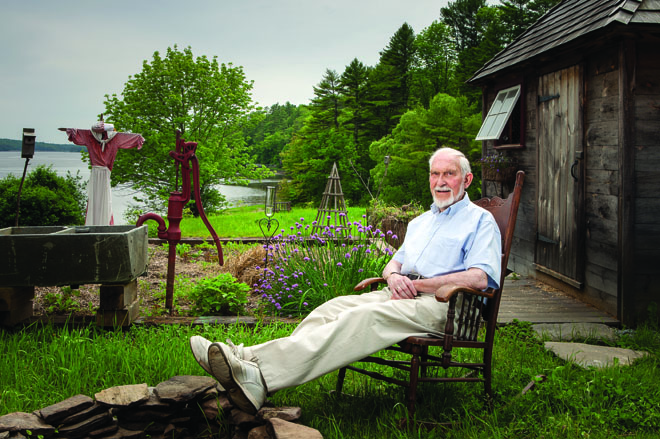The Architect as Humanist
AIA DESIGN THEORY – September 2012
Edited by Rebecca Falzano | Photography Trent Bell
William Thompson believes in an architectural approach that blends common sense and environmental psychology
William Magill Thompson has been practicing architecture for 60 years. Decades ago, when his practice got busy, he decided to take a sabbatical. In 1981 and 1982, he went to Scotland, to the University at St. Andrews, where environmental psychology was first offered as a subject of study. He found that in Scotland the impact of one’s surroundings is powerful and requires a presence of mind that today might be called mindfulness. “The people are friendly, they have learned how to get along over centuries, and they have a high regard for the beauty of the countryside. This is much the same way a porch allows us to greet a passing neighbor, to be open to not only the outdoors but to participate with people and not hide indoors, or retreat to the rear,” recalls Thompson. Looking back, Thompson believes he did his best work after that sabbatical. MH+D asked him to explain his approach and what environmental psychology means to him and the field.
Q: What does being a humanist mean in architecture?
A: To be a humanist is the architect’s first responsibility. We need architects who are not afraid to read more and do more to ensure that inspiration and imagination do not fall prey to trends technology fosters, that common sense and natural intuition guide us in our practices. We must be informed of the elements of our culture, from its beginnings. These fundamentals are our ethics, our history, our literature, art, music, and place. Of course, the magical sense of perspective and an awareness of economy of space and resources can be acquired, but the results are best when the creation is one made by a humanist. Over the years of my practice, I have witnessed how we repeat themes. Unfortunately, we also tend to repeat our mistakes. In Sticks and Stones, art critic Lewis Mumford wrote, “Architecture, like government, is about as good as a community deserves. The shell that we create for ourselves marks our spiritual development as plainly as that of a snail denotes its species. If sometimes architecture becomes frozen music, we have ourselves to thank when it is a pompous blare of meaningless sounds.” Even Steve Jobs, whom I greatly admired, accepted the relationship between content and process. We need to keep in touch, the visionary behind Apple’s success said, with our culture, our music, and our experience, as these contribute the backbone to content. How this is arranged is a combination of inspiration informed by the traditions of humankind.
Q: How does nature fit in with a humanistic approach to architecture?
A: The architect must also create harmony with nature. Good architecture should connect people with their natural surroundings, and this is not necessarily the direction we are taking with green design, which often results in a contradiction. As a species, we can adapt to a living situation that may not be as good for us, for our spirit. Most people are unaware; a lot are unhappy. How much of this is the unintentional consequence of design, of a shift from architecture that once was better informed by our culture, our past? We need to build healthy buildings, made without toxic materials, affording those who live and work inside them to have as much natural light as possible. A word recently coined that comes to mind is salutogenics. It is an approach to design grounded in biomedicine and psychology. I believe this new word synthesizes much of what I have put into my designs: common sense and environmental psychology. A lot of residential architecture today comes to us as visual cacophony. I am sad to say its elements reflect more sterility and illiteracy, following a technical direction that denies any cultural context. That leaves us with a built environment that no one can love. But we can get back to the garden, so to speak, by remembering a message delivered by David McCullough, that “learning about history is an antidote to the hubris of the present.” I see an urgency to stop the drift of architecture away from its role as a cultural force. We do not need “starchitects.” We need professionals who will question “how good is it?” rather than “how big is it?”
Q: What about new technologies for green design?
A: Our current preoccupation with green design is often a crutch for rationalizing. Spaces created without meaningful purpose, like vast entryways and multistory atria, and inappropriate materials, such as a glass wall designated for a north façade, waste resources. There is a “wink” to being green that is inauthentic. While we think we may be contributing to lower energy consumption, we might be really deluding ourselves. We run the risk of becoming lost to technology. We may even become subservient to it, forgetting it is a tool, not the master. To right ourselves, we must dig into our history and everything we call culture to expand our exposure to humanism. The architect has to guarantee that design is timeless, and this means he has to reacquaint us with human traditions of the ages, he has to connect us with our surroundings, even nature, and he has to provide a pleasing context for awareness, and meaningful and intentional lifestyle. Design runs the risk of being more about affectation than true sustainability, about pretense over comfort. We want architecture to endure. If the architect is a humanist, his/her creation will surely be more humanistic and it will pass the test of time.
American Institute of Architects
Maine AIA: 207-885-8888, aiamaine.org
William Magill Thompson: 207-315-5760




